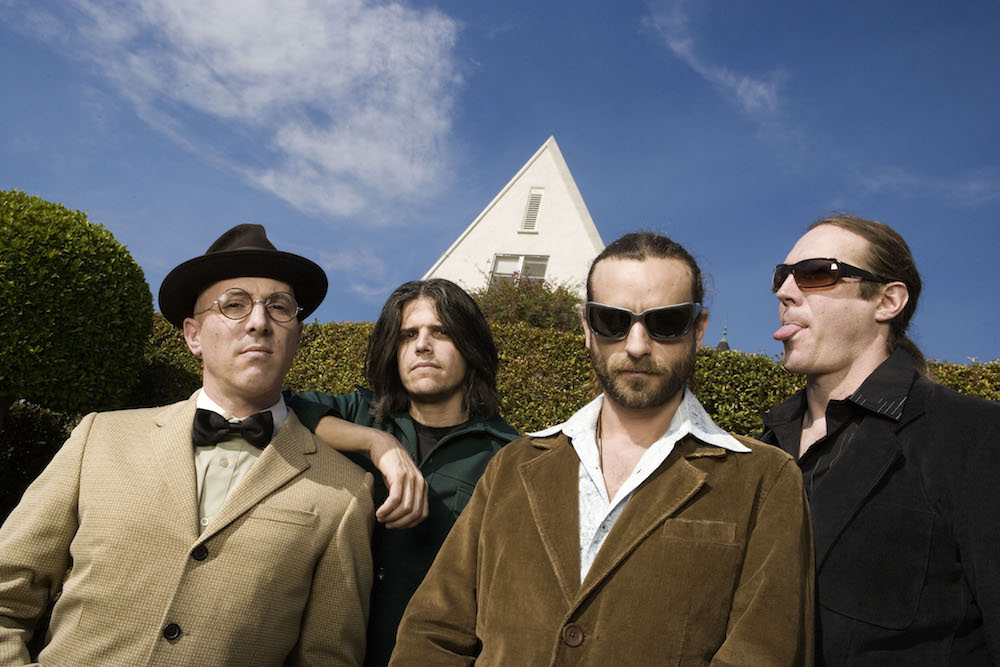Taking LSD and listening to Tool’s full-length debut Undertow is a bad idea. I’ve never done acid myself, but my inner voice has always held firm: “Don’t ever do that—and if you did ever do that, just be sure you’re not listening to that album when you do.” Released in 1993, Undertow practically rubs the listener’s nose in the most disturbing corners of the psyche. To listen to it, by definition, means having to confront ugly truths. Fans of heavy music tend to pride themselves on their tolerance for grim themes, but while Tool’s music seethed with anger and darkness, it tapped into a primal vulnerability that no amount of macho posturing could fend off. Back then, the band was genuinely scary.
We look back on the ‘90s through a nostalgic lens, so it’s tempting to regard the angst typical of the era as quaint. But it wouldn’t be fair to lump Tool in with, say, the self-immolating negativity of Nine Inch Nails’ 1994 landmark the Downward Spiral or even Korn’s blunt references to molestation and sexual pathology on their self-titled debut from the same year. You couldn’t just sum Tool up as rage draped around de-tuned guitar riffs. Yes, the riffs and the rage were both crucial, but the instruments all swayed within the tempo as if the entire band were playing underwater–a potently mesmerizing effect, especially when coupled with frontman Maynard James Keenan’s lyrics.
Even amidst the wave of transgression sweeping through the culture at the time, a song like “Prison Sex” stood out as especially provocative. Sung from the point of view of a childhood sexual abuse victim who in turn grows up to assault children, “Prison Sex” dares you to empathize with its protagonist, who ends up observing the “shit, blood, and cum on my hands” at the end of the song. As hard-hitting as that image is, you don’t have to take it literally to grasp its basic message: that we all, in some way, shape or form, perpetuate the patterns that have been inflicted upon us. Can you think of a song more brave in its willingness to go to such an ugly place?
I first heard Undertow in the drab, featureless dorm room of a college friend I used to smoke weed with. My friend was fond of taking hallucinogens and immersing himself in whole albums, and he had a particularly strong attraction to Tool. He insisted that if you watched Keenan perform, you would see that Keenan never blinked. Like my friend, I fell in love with the band’s music immediately, but found Undertow’s baleful intensity too gripping to handle even on weed. Now, to be fair, I once had an overly strong reaction watching a live Genesis DVD too. But I had good reason to be as wary of Tool as I was fascinated.
The grainy photos in the Undertow cd booklet oozed with a vibe that wasn’t quite body horror, but was still creepy and unsettling: Keenan’s teeth and gums enlarged through a magnifying glass, his mouth pried open; original bassist Paul D’Amour with acupuncture needles stuck in his face; drummer Danny Carey’s face rendered as a blur. (“That’s what people’s faces look like when you trip,” my friend explained.) And then there’s the centerfold picture of the band’s drum tech lying naked on top of a full-figured model, also nude. That should have been the first clue that Tool enjoyed pulling your leg just as much as pushing your buttons, but the line was too blurry to tell the difference.
As a total package, Undertow looked a hell of a lot like a gateway to other, likely dangerous, planes of perception. Clearly, Tool wanted you to think as much, from Carey’s use of sacred geometry on screens behind his drum kit to the band’s self-presentation as adherents of lachrymology, or “the science of crying.” In a 1993 piece that ran in Spin as a preview of that year’s Lollapalooza, Keenan described the practice as “an individual approach to delving into suffering.” Of course, we now know there’s no such thing as lachrymology, but speculating about it with my friend gave me a titillating thrill, as if we’d discovered a secret underground cult. It’s endearing to think than an entire generation of fans was sitting in bedrooms, imagining mysterious rituals just like we were.
https://youtube.com/watch?v=F5sIXUbMgF0
In that same piece, Keenan was also quoted as saying “You’ll hear what you want to hear; you’ll hear what you need to hear” in the band’s music. My friend certainly did. Undertow closes with a miasmic aural collage titled “Disgustipated,” which begins with a gentle sound that resembles a wood block. I can still remember my friend, his voice grave, turning to me and saying, “You have to trust me on this. I listened while tripping and I know–I know–that’s the sound of a guy jerking off.” I had to fight back laughter, but who was I to tell him he was wrong? (Months later, when I saw the band live for the first time, I stared at Keenan and, to the best that I could tell, never once saw him blink.)
Tool struck gold with Undertow, propelled in part by heavy MTV rotation of the eye-popping claymation videos for songs like “Prison Sex” and “Sober,” both the brainchildren of guitarist Adam Jones. The band became a household name and a staple of corporate radio with the follow-up, 1996’s Aenima, the first indication that Tool’s outlook was shifting from bellicose self-reflection to something resembling new age mysticism. Then the gaps between albums started getting longer. Between Aenima and 2001’s Lateralus, the alternative rock paradigm essentially cratered, yet Tool re-emerged just as relevant as ever. The band took another five years to put out 10,000 Days, but went on to headline Bonnaroo alongside Wilco and the reunited Police.
Ten thousand days haven’t gone by since that album’s release—that would be a little over twenty-seven years—but it’s beginning to feel that long. The tenth anniversary of the release of Tool’s latest album came and went at this time last year. Even Kabir Akhtar, the one-time superfan who founded the fansite toolshed.down.net, started to lose hope ages ago. Launched when Akhtar was a sophomore undergrad—he’s now an Emmy-winning TV editor/director who’s worked on shows like Arrested Development and New Girl as well as the Academy Awards—the Toolshed, named by Keenan himself, actually pre-dates the band’s official site. It was once a go-to destination for insider info and a haven for fans to chat with one another, before the advent of social media and blogs. Needless to say, the geek-out quotient was quite high.
By any generous measure, eleven years is an interminably long wait. There’s still no official word about when we can expect new music, even though the band has issued sheepish, none-too-reassuring hints for years now. Somehow, though, Tool continues to maintain its hold on the public without so much as trying. All but a handful of the North American dates the band is scheduled to play this May and June have sold out without the benefit of a single, aggressive promotion, or even so much as a tease for a new release. Meanwhile, these days young children perform Tool songs on YouTube, in widely celebrated clips like this one (with over 14 million views) and this one (which features Carey himself).
Watching those two clips, the contrast between what this band represented 25 years ago and its current position looks deliciously preposterous. It’s strange to think that a band this uncompromising could burrow so deeply into our collective awareness. Not long after the release of 10,000 Days, the band’s official website served a parallel function as a kind of incubator for alien abduction narratives. Carey himself shrugged it off as goofy fun at the time, but it was clear that Tool had intentionally positioned the website to cater to a fringe community of UFO enthusiasts—another example of stoking a sense of mystique while also capitalizing on the habits of an audience that had come of age just as online interaction started driving music careers in the mid-’90s.
Sadly, the extraterrestrial-themed pages are no longer active on the site, which has now been molded into the generic industry standard. The tongue-in-cheek humor is gone, but if you Google terms like “Tool band alien abduction,” a delightfully strange rabbit hole of message board activity opens up. You might want to go down that rabbit hole, because once this run of shows wraps up this summer, who knows how much longer it’ll be for an album that more and more looks like it’s turning into a white whale for a following whose devotion apparently knows no bounds.





